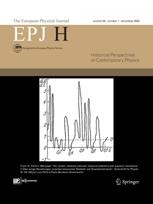Unpacking the mystery of Feynman’s reference amplifier
A review of lectures given by Feynman between 1946 and 1971 showcase the strong influence that his involvement in the Manhattan Project held on his research, while revealing an intriguing mystery surrounding one particular amplifier device.
New York | Heidelberg, 13 December 2019
 Richard Feynman was one of the 20th century’s most celebrated physicists. In 1943, he began his career in the Manhattan Project, where one of his tasks was to develop a device which could count the neutrons produced by nuclear reactions. Neutron signals emerging from counters must be strongly amplified to achieve this, but in the 1940s, practical amplification devices were hindered by their distorted signals. To overcome the issue, Feynman proposed a theoretical ‘reference amplifier’, which could provide amplifiers with a standard signal to be compared with. Through analysis published in EPJ H, researchers at the University of Naples, Italy, propose that this line of research exemplifies the influence which Feynman’s involvement in the Manhattan Project held over his later teaching and research.
Richard Feynman was one of the 20th century’s most celebrated physicists. In 1943, he began his career in the Manhattan Project, where one of his tasks was to develop a device which could count the neutrons produced by nuclear reactions. Neutron signals emerging from counters must be strongly amplified to achieve this, but in the 1940s, practical amplification devices were hindered by their distorted signals. To overcome the issue, Feynman proposed a theoretical ‘reference amplifier’, which could provide amplifiers with a standard signal to be compared with. Through analysis published in EPJ H, researchers at the University of Naples, Italy, propose that this line of research exemplifies the influence which Feynman’s involvement in the Manhattan Project held over his later teaching and research.
The study delves into an intriguing mystery surrounding Feynman’s research: an amplifier design which gives the most stable signals but cannot be practically realised. According to the Neapolitan researchers, the design appears to stem from earlier theories which disregarded relationships between mathematical formulae and real life. Therefore, Feynman may have simply viewed the idea as an interesting thought experiment; but perhaps, the researchers propose, he had hoped that the technology it required would one day be realised. Furthermore, he derived equations regarding the ‘causality’ properties of amplifiers, which describe relationships between frequency and phase shift that real amplifiers must satisfy in order to operate. He returned to this idea in a series of lectures he gave at the Hughes Aircraft Company in 1970-71.
The Italian team explored the mystery by reviewing both Feynman’s Hughes lectures, and an earlier series he gave at Cornell University in 1946-47, soon after leaving the Manhattan Project. Their research gives a clear overview of how Feynman’s approach to physics was strongly shaped by the highly controversial project. Ultimately, their insights serve as a reminder that even over 30 years after his death, and in topics outside of his main area of expertise, Feynman’s genius continues to present intriguing challenges to today’s physicists.
References: V. d’Alessandro, S. Daliento, M. Di Mauro, S. Esposito, A. Naddeo (2019), Searching for a response: the intriguing mystery of Feynman’s theoretical reference amplifier, European Physical Journal H, DOI 10.1140/epjh/e2019-90071-6
Further Information
For more information visit: www.epj.org
Services for Journalists
The full-text article is available here.
Contact
Sabine Lehr | Springer | Physics Editorial Department
tel +49-6221-487-8336 | sabine.lehr@springer.com
